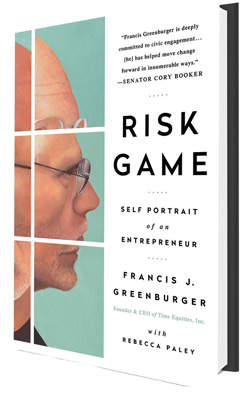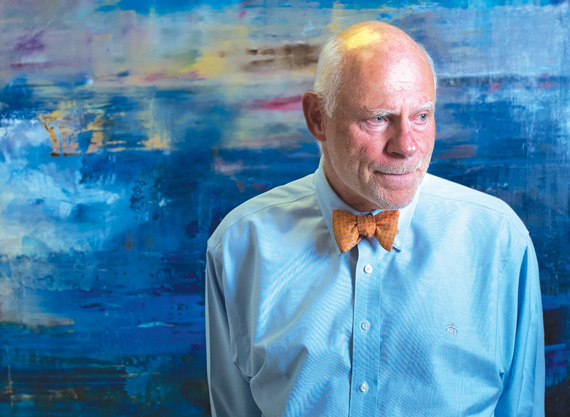Francis Greenburger, the CEO of Time Equities and former “King of Co-ops,” has long been the industry’s renaissance man. From his early days in the 1980s as a real estate magnate who feasted on rental-to-co-op conversions to his decades-in-the-making development of 50 West Street — a $550 million, 189-unit luxury condominium in Lower Manhattan — Greenburger has quietly nurtured several side interests throughout his real estate career, including a successful literary agency.
Sanford J. Greenburger Associates, founded by his late father, has discovered blockbuster writers such as Dan Brown (of “The Da Vinci Code” fame), Nicholas Sparks (“The Notebook”) and Dave Eggers (“A Heartbreaking Work of Staggering Genius”). The developer has said that he himself plucked James Patterson out of the slush pile, representing him briefly in the 1970s before the author left his agency (more on that later). Patterson is, of course, known for being a one-man publishing conglomerate, having released 156 books that have sold more than 325 million copies worldwide.
So it’s safe to say that Greenburger knows a thing or two about bankable writers and books. Yet for his own authorial debut, titled “Risk Game: Self Portrait of an Entrepreneur,” the 67-year-old has curiously written a work that defies convention when it comes to stories by and about business moguls. Set to be released this month by independent publisher BenBella Books, the 301-page book, co-written by Rebecca Paley, is a winding memoir that’ s more confessional than self-aggrandizing. “Art of the Deal” it is not. The author delves into his days as a 12-year-old hanging out with European intellectuals in his father’s agency (while serving as its hard-nosed bookkeeper and contract negotiator) and skinny-dipping with writers and editors in the Hudson Valley.
He also relates his gut-wrenching personal tragedies, including the accidental drowning of his two-year-old son Alexander and his son Morgan’s struggle with mental illness and resulting incarceration, which has led Greenburger on a well-publicized crusade to reform the country’s criminal justice system. In New York, the Greenburger Center for Social and Criminal Justice has proposed a $12 million facility in the Bronx to house 16 mentally ill inmates as part of a six-year pilot program.
 In an interview with The Real Deal, Greenburger confessed that he knew the book would not be easy to market. He showed it to several friends in publishing, he said, one of whom flatly told him, “I love the book, but to be honest, I don’t know how to sell it.” Wearing his trademark bow tie, the developer reflected on his life from his art-filled and book-lined offices in Gramercy Park, which is home to both Time Equities and his literary agency. “I just decided that this was the story I wanted to tell,” he explained. “This is about the spectrum of my life.”
In an interview with The Real Deal, Greenburger confessed that he knew the book would not be easy to market. He showed it to several friends in publishing, he said, one of whom flatly told him, “I love the book, but to be honest, I don’t know how to sell it.” Wearing his trademark bow tie, the developer reflected on his life from his art-filled and book-lined offices in Gramercy Park, which is home to both Time Equities and his literary agency. “I just decided that this was the story I wanted to tell,” he explained. “This is about the spectrum of my life.”
That spectrum has included Heinrich Maria Ledig-Rowohlt, the famed German publisher; Clement Greenberg, the influential 20th-century art critic, who helped Greenburger, an avid art collector, establish Omi International Arts Center, an acclaimed nonprofit in upstate New York that hosts artist residencies; and presidential candidate Hillary Clinton, whom Greenburger has backed since her 2000 campaign to become a U.S. Senator from New York.
But the extremes of his life are never more apparent than when he visits his son in prison. He describes the experience of being picked up by his driver and taken to a desolate corner in Queens where he needs to catch a city bus destined for Rikers Island. “I had no idea what to expect, as was quickly evidenced by the fact that my MetroCard didn’t have enough money on it for a single ride,” he writes.
While real estate takes a back seat at times, the memoir makes it clear that once Greenburger discovered he could make a profit subletting prime-located walk-up office spaces to small businessmen in the 1970s (a nascent version of WeWork), he was hooked on buying and repositioning properties. One of the book’s notable revelations is that Patterson, who published his first novel, “The Thomas Berryman Number,” under Greenburger’s dogged representation, handed him an ultimatum: Give up real estate or lose him as a client. Patterson didn’t want an agent who wasn’t singularly devoted to his job.
“I didn’t need to think two seconds about my answer,” Greenburger writes. “There was no contest. I wasn’t going to let any author, not even James Patterson, put an end to my real estate ventures.”
Greenburger would, of course, go on to specialize in co-op conversions, repurposing more than 10,000 units in over 100 New York City buildings. The pace of his success was astonishing, a reflection, in part, of the flush lending years of the 1980s. As an example, he states that in 1978, he was able to string together $35,000 in loans from seven different banks. Less than five years later, on the basis of his portfolio of properties, Chemical Bank gave him a credit line of $100 million.
But real estate is all about surviving cycles, and industry players will appreciate the up-close account of Greenburger being on the brink of financial disaster, beginning in the late 1980s, when the market suddenly shifted and bank lending dried up. His attorney recommended making a preemptive strike by going to the state Attorney General’s office and confessing that he was in crisis even though he hadn’t yet defaulted on a single loan. His COO warned that such a move amounted to professional suicide. Greenburger decided to come clean anyway. But although he built up good will with regulators, helping the state devise a new disclosure amendment for co-ops, the headlines (one of which read, “Co-op King Bankrupt”) hurt him with lenders. During this time, none other than Donald Trump came over to Greenburger at a charity dinner to offer his sympathies. “Trump was coming to see what it smelled like,” Greenburger writes of the now Republican presidential candidate. “And it didn’t smell good.”
More recently, the developer stood on the precipice with 50 West Street, the aforementioned luxury skyscraper that he started in 2008 and was forced to halt development on for nearly four years, due to the financial crisis. Today, the luxury condo project is more than 60 percent sold with an expected sellout of $1 billion.
The arc of 50 West illustrates how protracted development can become in the face of bureaucratic changes, economic cycles and other unforeseen events. Having acquired the property in 1980, when it contained an office high-rise called the Crystal Building, Greenburger was in the process of converting it into condos when the 9/11 terrorist attacks occurred. The circumstances gave way to a bolder plan, a decision the developer attributes in his book to a thirst more personal than financial — he had never before built a skyscraper. But once the recession hit, he was saddled with debt and once again tempted to quit.
For Greenburger, someone who pursues hidden value, be it in real estate, authors or political underdogs, the book above all else demonstrates his willingness to follow his gut — and take a risk. “Saying no is the most important judgment you make,” he writes. “On the other hand, nothing happens until you say yes.”




